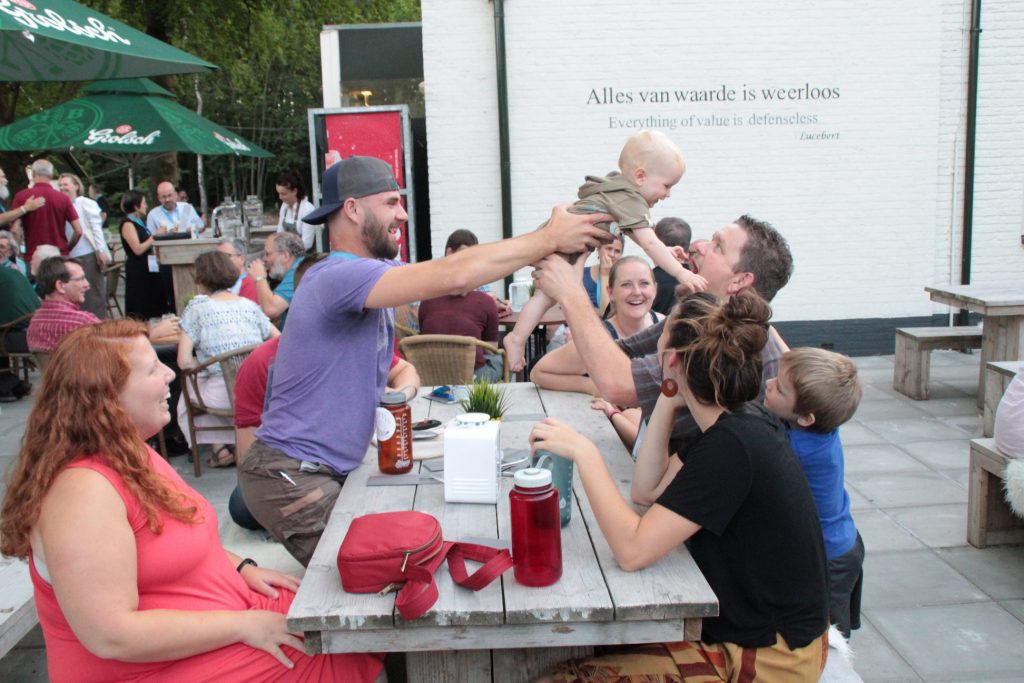The second Global Mennonite Peacebuilding Conference and Festival, held June 27-30 in the Netherlands, drew more than 200 peacebuilders, including Bible, religion and theology professor and Peace Commission secretary Andrew Suderman and Intensive English Program director Karen Suderman. Gloria Rhodes, associate professor of peacebuilding and conflict studies, presented on personal formation for peacebuilding practice.
Senior Lindsay Acker, Nicole Litwiller ’19 and Luke Mullet ’19 also presented their project Do Not Discard, which includes stories from survivors of sexual violence, visual art and audio accompaniment. Acker and Litwiller are now studying at the Center for Justice and Peacebuilding, while Mullet has joined EMU’s admissions team. Junior Aaron Horst was also present.
The following article from the August 5, 2019, issue of Mennonite World Review is reprinted with permission.
ELSPEET, The Netherlands — More than 200 peacebuilders launched a Global Anabaptist Peace Network at the second Global Mennonite Peacebuilding Conference and Festival June 27-30 at Mennorode retreat center.
Rooted in Mennonite World Conference’s Peace Commission, the network hopes to share prayer and advocacy requests, empower one another, develop a membership directory of peace-related Mennonite organizations and create spaces for encounter.

During the conference, panels, workshops, concerts, live theater, poetry reading, singing, prayers and other activities explored the theme “On the Way of the Pilgrimage of Justice and Peace,” building on an ecumenical initiative promoted by the World Council of Churches.
One of the goals was to create a network of people from different contexts and fields related to Mennonite peacebuilding. Renate Enns, one of the volunteers, was moved by how connection grew during informal moments.
“Everyone engaged with each other anytime,” Enns said. “You saw people from different ages and contexts talking with each other. That made this conference special. It showed that people really wanted to listen to each other.”
Paulus Widjaja spoke about the challenges of working with Christians and Muslims in Indonesia.
“Peacebuilding is not meant to just end conflict but to prevent future conflicts by building strong infrastructure,” he said.
Widjaja’s reference to infrastructure exemplified the importance strengthening relations among Mennonite peacebuilders, learning from peace practices and discerning together about ways to engage with different contexts.
Presenters, panels and artistic performances addressed racism, colonialism, discrimination, exclusion and gender-based violence. Theatre of the Beat’s play #Churchtoo confronted people with issue of sexual abuse in churches. It was a catalyst for weighty questions, and many people were brought to tears.
Comforting for peace
One activity was “Comforting for Peace,” under the guidance of Jeannette Stenvers and Marjan Huisman. Participants contributed to stitching comforters for refugees. One was made around the theme of “Mennonites and Peacebuilding.”
More than 100 participants designed single patches to be sewn into a comforter and offered to the World Council of Churches as a sign of how Mennonites are joining the ecumenical “Pilgrimage of Justice and Peace.”
Jeannette Stenvers was moved not only by the number of people who joined to let their hands work for peace but also by the connections people made during this work and the many stories it brought out.
As the Global Anabaptist-Mennonite Peace Network was launched, Fulco van Hulst, a representative of the emerging network, said: “In God’s grocery store we cannot buy things like world peace and the end to hunger but only the seeds of peace to spread across the world.”
The first conference was organized in 2016 by Conrad Grebel University College in Waterloo, Ont. Eastern Mennonite University in Harrisonburg, Va., has expressed willingness to organize a third conference in 2022 but welcomes a bid from an institution in the Global South to host instead.
